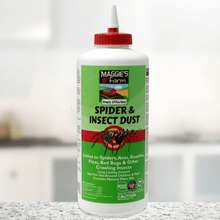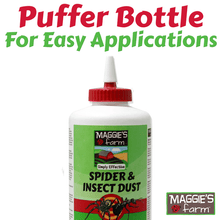DIRECTIONS FOR USE
Always read label directions and precautions prior to use. This product can be used indoors and outdoors.
This product is a dust and can be puffed straight from the bottle. Unscrew the main top, take out the foam liner, then screw the top back on. Remove the green cap and cut 1/8” off the applicator nozzle to open up a small hole. The bottle is now ready to be used as a puffer applicator. A small paint brush can be helpful to brush dust along edges and into cracks.
Don’t use this product in the same area where you’ve used a Maggie’s Farm insect bait. Baits work by the insect eating them. This product is a contact killer and repellent, so you want to be sure not to repel insects from an area where you put down bait.
Dusts tend to work slower than sprays, but they tend to last much longer, up to 6 months. They are good for applying to places spiders and insects hide and to places where pests might enter a building. Dust is also good for directly treating nests and infested wall voids. Apply, as a light dusting, at a rate of about 2 oz per 100 sq ft. If directly treating a nest or an area with a number of pests present, a heavier dusting is recommended.
General Pests (Spiders, Ants, Cockroaches, Earwigs, Silverfish, Mites, etc.): Apply dust in attics, basements, trash and utility closets, behind or along baseboards, in drawer wells and hollow furniture legs, under and behind appliances, in wall voids and voids under and behind cabinets, sinks and tubs, in weep holes in brick or siding, around basement drains, around electrical conduit and pipe runs and in other cracks and crevices where pests may hide or enter buildings. Focus application in areas where pests or their signs are seen.
Application tips for some areas:
1. In attics, be sure to get dust near the eaves and vent pipes where insects often first enter, as well as around any pipes or potential access points between the attic and the main structure.
2. When treating cabinetry areas, if there is no gap between the lower cabinets and the kickplate, then small holes can be drilled to access the voids. Escutcheon plates around pipes can also be pulled back to allow access to voids.
3. The bottom drawers in kitchen and bathroom cabinets can be removed and dust applied into drawer wells.
4. Electrical switch plate covers can be removed to allow access to walls voids.
5. If there are cracks between baseboards, cabinets, doorframes, hinges, counters or trim, and walls, these cracks can be lightly dusted with product. If practical, these areas can be sealed once insect problems have been eliminated to help prevent future problems.
6. Insects need moisture, so kitchen and bath areas and areas immediately surrounding them, and any other damp areas should be carefully inspected and treated if necessary.
Fleas, Lice and Ticks: Treat kennels, pet bedding/rest areas, floor and floor coverings, cracks behind molding and baseboards and other areas where pests may harbor. Don’t use for human head lice.
Grain/Seed and Fabric/Clothes Infesting Beetles and Moths: Treat cracks, crevices and along the edges of cupboards, closets, drawers, pantries, shelving units and storage bins. Treat voids beneath drawer units by removing the lower drawers and treating the well. Treat the voids beneath shelving units or cabinets by removing the kickplate or drilling small access holes in the kickplate. Treat under rugs and along the edges of carpets and baseboards and other infested areas to control carpet beetles.
Bed Bugs: This product can provide some residual protection against bed bugs, but should not be used as the sole treatment. We recommend you contact a professional if you have bed bugs. Remove bedding and take the bed apart. Treat the interior framework, joints and cracks in the bed frame. Treat the tufts, folds, edges, and the interior framework of the box spring. Treat behind wall-mounted headboards. Treat moldings, hollow furniture legs, cracks and crevices, along baseboards, under carpet tack strips and any areas with visible signs of infestation. Treat upholstered furniture by removing or lifting (if possible) the cushions and treating the undersurface. Treat the interior framework, cracks and joints of the furniture, and the folds, tufts and edges of cushions and other upholstered areas. Do not treat toys and stuffed animals with product. Treat wall voids as noted in the general pest section.
Treatment of Nests in Walls and Infested Wood: Ants, stinging insects and wood-destroying insects can build nests in wall voids or infest structural wood. Locate areas where insects have infested including nests, tunnels, galleries and cavities and inject dust into the area. Drill small holes 8-10” apart in the infested area to be sure nests and galleries can be treated thoroughly. For Carpenter bees, treat the entrance holes and then plug with stainless steel wool. For termites, this product is only a supplemental treatment to kill workers and winged forms that are present in the area when you treat. It is not recommended as a substitute for a professional treatment. For any infestation of a wood-destroying pest where structural damage has occurred or could occur, we recommend you contact a professional.
Ground Nest Treatment – Ants and Stinging Insects: For ants, cover the mound with dust and gently puff dust into the nest entrance. Be careful not to disturb the mound, particularly when treating fire ants. Repeat a few days later if there is still ant activity. For best results, treat the area with a granular ant bait first, then follow-up with direct nest treatment with this product a week later. For stinging insects, be careful when treating nests and cover as much of your skin as possible with clothing. Individuals who are allergic to insect stings should never treat stinging insects. Have someone else do the treatment or call a professional. For best results, treat in the early morning or late evening when the largest number of insects will be in the nest. Thoroughly coat the nest entrance with dust and puff carefully into entrances if this can be done without disturbing the nest structure. Repeat a day or two later if there is still activity. For hanging or tree nests, a better option is an appropriately-labeled spray product. Certain species such as yellow jackets and hornets are very aggressive. Use extreme caution when treating these insects, or call a professional.
Plant Pests: Dust infested plants lightly. For best results, try to get the dust on the underside of leaves. Repeat after a couple of days if needed.








